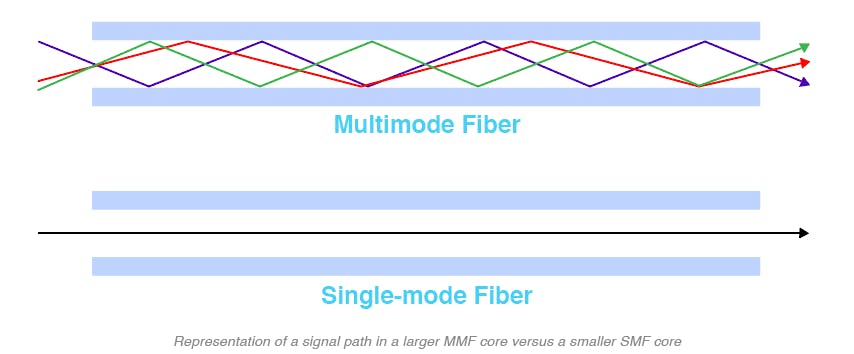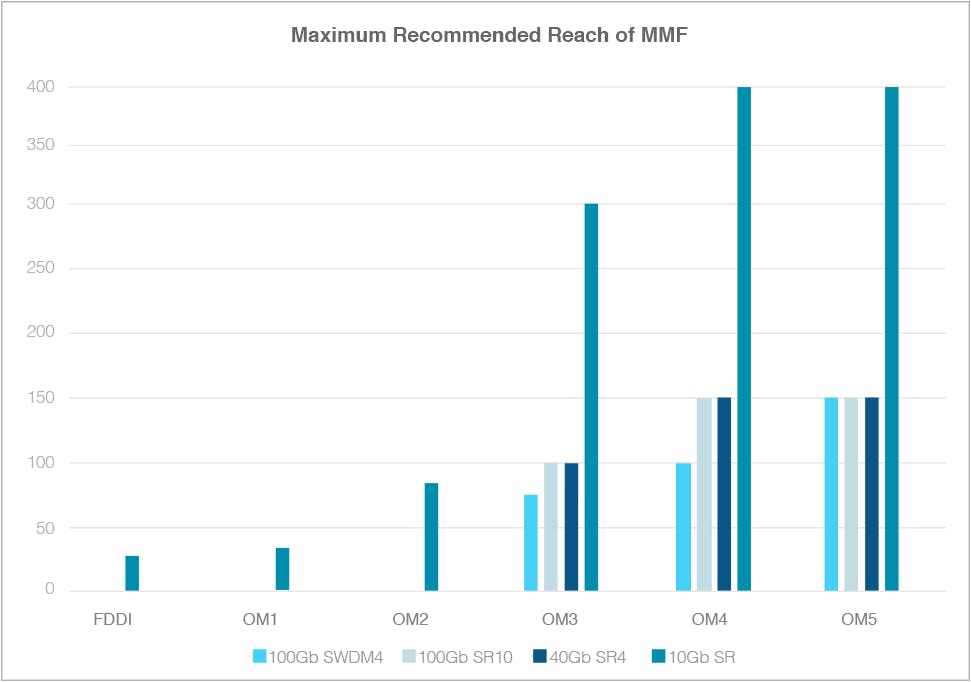Knowing which cable is right for you can greatly impact your network.
These multi-mode fiber types use the acronyms of “FDDI” for Fiber Distributed Data Interface and “OM” for optical multi-mode and have slight differences between each iteration. As technology advances and speeds of fiber optic data transmission increase so does the bandwidth needs of the cabling used to create the connection.
Of these differences the main ones are the core size, in microns or µ, and modal bandwidth. The core sizes can be summed up by a general rule, the larger the core size the farther the signal needs to travel within the core due to the size of the waves. Thus larger cores limit the maximum length of the cable Single-mode fiber or SMF has a very small core (9µ) which allows the signal a more direct path to its destination. Multi-mode fiber or MMF uses a larger core (50µ or 62.5µ) which allows for lower cost transmitter types.

Modal bandwidth refers to the maximum signaling rate or maximum distance for a given signaling rate. The greater the bandwidth the greater capacity of a fiber to transmit information. This determines the distance each Ethernet variant can reach over that type of fiber. Modal bandwidth is represented in terms of MHz per kilometer and is derived by the modal dispersion of the fiber and the spectral linewidth of the laser.
One of the earlier instances of fiber optics used in data connections was FDDI, the transmission rate was typically 100Mb and FDDI grade cabling was used. This cabling was typically orange in color and was used by a lot of early adopters of fiber optics data transmission including government and financial institutions and was quite capable of carrying lower speed transmissions great distances.
The next iteration, OM1, is also typically orange in color and was another early instance of multi-mode fiber primarily used in pre-gigabit networks at its inception. It is most commonly used for 100Mb Ethernet applications and short reach 1Gb applications. This orange jacketed cable is best suited for LANs or SANs, and is recommended for connection between fiber patch panels, hubs, switches, media converters and routers. As OM1 is also capable of carrying 1Gb speeds it has remained intact through network infrastructure upgrades throughout many organizations.
The core size first changes in OM2 going from 62.5µ to 50µ. OM2 supports 10 Gigabit Ethernet for shorter lengths, but is more commonly used for 1Gb Ethernet applications. It continues the use of the orange jacket color and is specifically rated for gigabit Ethernet LANs.
OM3 ushers in the era of laser optimization or laser optimized multi-mode (LOMM) cabling. Where OM1 and OM2 are well suited for simple LED based transmission OM3 is optimized for more complex transmission allowing for the use of 10Gb and beyond transmission speeds. It begins the standard aqua color per the standard and is optimized for 850nm VCSELS. While OM3 is capable of 10Gb, 40Gb and even 100Gb transmission speeds it is most commonly used in 10Gb applications.
Evolving from OM3 comes OM4, it is also aqua in color per the standard and is optimized for 10Gb, 40Gb and 100Gb speeds. The substantial increase in bandwidth from OM3 to OM4 allows for further transmission distance of all transmission speeds over OM4 cabling because of this OM4 is widely used in datacenter and high bandwidth need applications.
The newest, OM5 cabling, is not only reverse compatible with OM3 and OM4 but it is also capable of short wavelength division multiplexing or SWDM. Support for SWDM will allow for much greater speeds through high speed transmission over multiple lower wavelength channels. The use of SWDM in datacenter applications will mean substantial cost savings due to the use of lower cost transmitters such as VCSELs.
